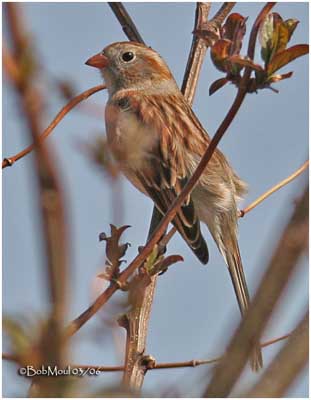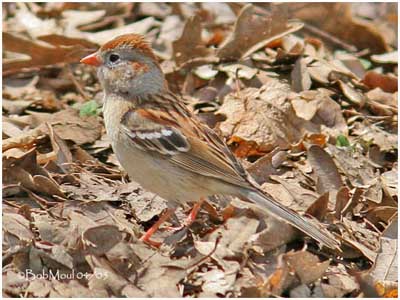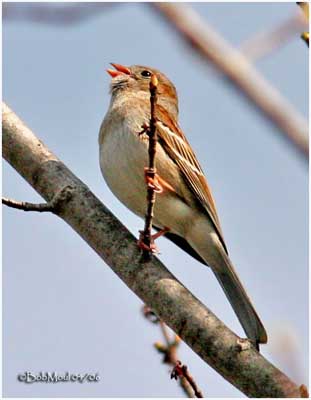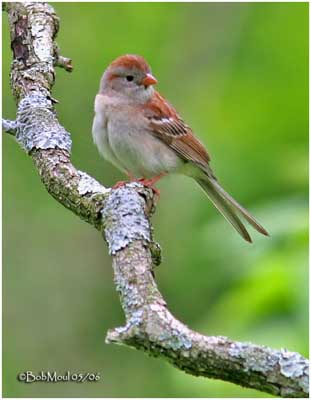
Fields Sparrow
Spizella pusilla
Passeriforme Order – Passerellidae Family
BIOMETRICS:
Length: 12-15 cm
Wingspan: 20 cm
Weight: 11-15 g
LONGIVITY: Up to 8 years
DESCRIPTION:
Field Sparrow has grey face with reddish crown and thin white eye-ring. Bill is bright pink. Its back is streaked, except on grey-brown rump. Breast and sides are buffy red. Belly is greyish-white.
It has a long brown tail, forked and edged with pale grey. We can see white wing bars on the brown wings.
Field Sparrow has a rusty brown streak behind eye and on ear feathers. Eyes are black. Legs are pink.
Both sexes are similar, but male is slightly larger.
Juvenile is streaked below. Wing bars are buffy. It’s duller than adult.
DIET:
Field Sparrow feeds on weed seeds, grass, seeds, insects and spiders. Summer diet is made up of mostly insects and some seeds. In winter, seeds are the main food. Young are fed insects, and mostly spiders.
PROTECTION / THREATS / STATUS:
Field Sparrow has increased greatly, following European colonization, due to clearing of forest lands. Numbers have declined over the past century as forest areas have regrown. They are still widespread and abundant however.
Field Sparrow is a frequent Brown-headed Cowbird host. Some studies show that about 45 % of nests parasited are deserted by Field Sparrow.
Fr: Bruant des champs
All : Klapperammer
Esp : Chimbito Llanero
Ital: Passero dei campi
Nd: Veldgors
Sd: Åkersparv
Photographs by Bob Moul
His website:
Nature Photography
Text by Nicole Bouglouan
Sources:
A GUIDE TO THE BIRDS OF MEXICO AND NORTHERN CENTRAL AMERICA by Steve N. G. Howell, Sophie Webb - Oxford University Press - ISBN: 0198540124
BIRDS OF THE GREAT BASIN – by Fred A. Ryser - Univ of Nevada Pr -ISBN: 0874170796
FIELD GUIDE TO THE BIRDS OF NORTH AMERICA - National Geographic Society - ISBN: 0792274512
All About Birds (Cornell Lab of Ornithology)
What Bird-The ultimate Bird Guide (Mitchell Waite)
Wikipedia (Wikipedia, The Free Encyclopedia)

VOICE: SOUNDS BY XENO-CANTO
Field Sparrow’s song is a series of clear, plaintive whistles, accelerating into a trill.
HABITAT:
Field Sparrow breeds in old fields, in open bushy woodlands, fields and pastures with their weeds and bushes. It winters in fields and forest edges. Field Sparrow needs good singing perches, so prefers areas where half of the woody vegetation is higher than 5 feet high.
RANGE:
Field Sparrow breeds from eastern Montana eastward to southern Quebec and southern Maine, and southward to Central Texas and north-eastern Florida.
It winters from Kansas, Illinois, Pennsylvania and Massachusetts southward to very north-eastern Mexico and northern Florida.
BEHAVIOUR:
Field Sparrow often feeds directly on fallen seeds. It perches on top of grass, let its weight carry the stems to the ground, and then, it removes the seeds. It feeds on the ground or in low-lying vegetation.

Field Sparrow male usually returns in the same territory to breed. Female and young prefer to change. Male sings as soon as it gets back in spring, and it sings until it finds a mate. After, its sings occasionally.

When a predator comes into the nest site, adults use the “broken wings” to lure it. When alarmed, Field Sparrow flies to exposed position on top of bush or low tree, where it can watch and await developments.
In the fall, they frequently gather in small flocks. If disturbed all will fly to the nearest bushes, and in perching will cluster close together.
FLIGHT:
Field Sparrow has a strong flight.
REPRODUCTION:
After examining several sites, female chooses a site and builds her nest alone. Mate often is nearby and may offer some nesting materials. Field sparrow’s nest is placed on or near the ground in grass clumps or at base of shrubs. It’s an open cup of large grass pieces, interwoven with finer grasses. It’s lined with fine grasses, rootlets and hair.
Female lays 3 to 5 creamy-white eggs (occasionally greenish or bluish-white) marked with brown spots. Incubation lasts about 10 to 17 days, by female. The young fledge 7 to 8 days after hatching, but remain near the nest for about another week. Both parents feed the young until they are independent, at about 26 to 34 days old.
Field Sparrow is monogamous. Two or three broods are produced per season. For the first clutch, the nest is on or near the ground, but for the others broods, as the ground cover grows taller, it’s built in small shrub or sapling.
